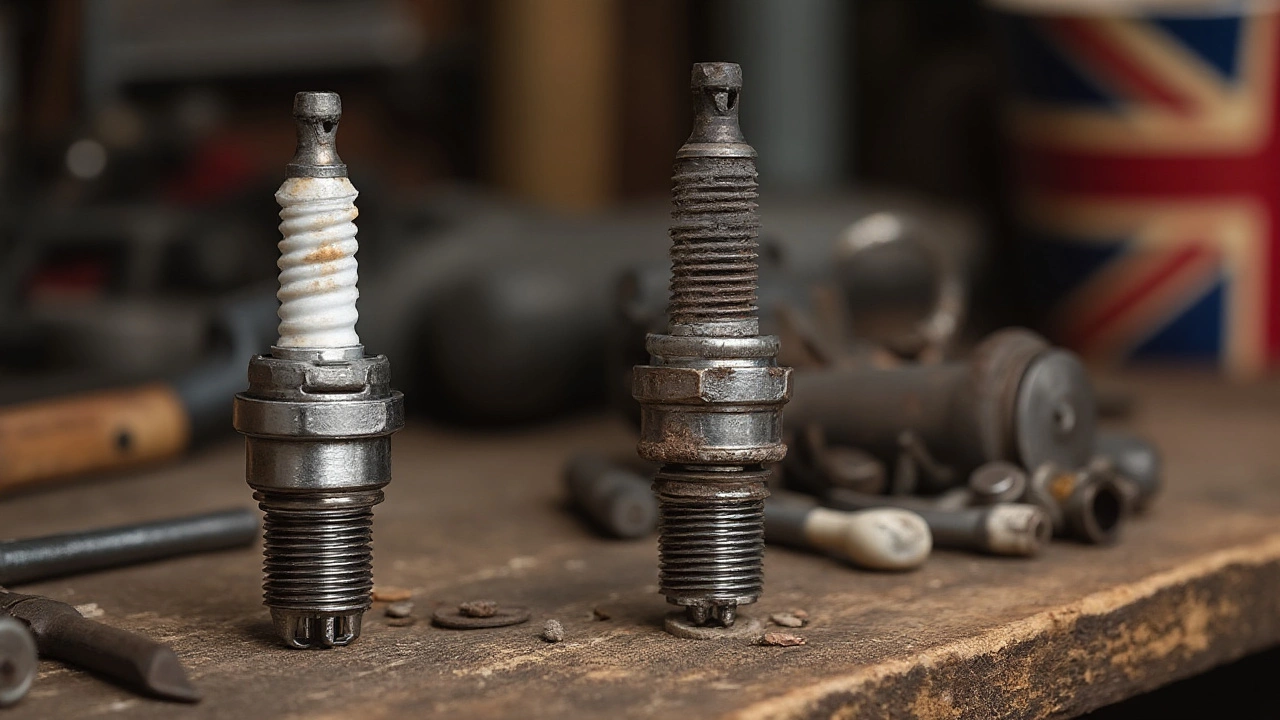Ever heard a car engine sputter or felt it sluggish on the road and instantly started dreading a hefty repair bill? Most people don’t think twice about spark plugs—until their car starts throwing a tantrum. These tiny, unassuming parts do the vital job of lighting your car’s fuel-air mix, making everything run. But do they really need to be changed as often as mechanics suggest, or is that just another way to get you into the shop? There’s a lot of confusion and some myths floating around. If you’ve ever wondered how far you can stretch a set of spark plugs, or what really happens if you ignore them for too long, let’s clear things up. It’s not as simple as every 30,000 miles, and not all spark plugs work the same. Turns out, this is a little more interesting—and important—than most folks realize.
What Spark Plugs Do and Why They Matter
Spark plugs are what stand between a smooth ride and a rough day. Without them, your engine simply won’t start, let alone move you anywhere. They ignite the mix of fuel and air inside your engine’s cylinders. This creates a tiny, controlled explosion (don’t worry, it’s safe!)—and that’s what powers your car. Millions of these mini-explosions happen every time you take a drive, and spark plugs do all this while exposed to crazy heat and high pressure. Even though they’re small, they take a beating every time you turn the key.
Even brand-new spark plugs start wearing down from the moment they’re installed. Each spark erodes the electrodes—a microscopic bit at a time. This might sound harmless, but after thousands of miles, that wear adds up. Dirty or worn spark plugs can make engines misfire, waste gas, or suddenly refuse to start. That’s why auto experts and car manuals emphasize keeping them in good shape.
Here’s what makes it even trickier: not all spark plugs are built the same. Some are made with copper, others with platinum or even iridium. The material matters because it affects how long the plugs last and how well they handle heat. Old-school copper plugs usually need more frequent replacement, while more expensive iridium or platinum plugs can last double or triple the distance.
If you’re a fan of stats, here’s something concrete. According to Bosch, a top spark plug maker, “Iridium plugs can last up to 120,000 miles under good conditions, while copper may need changing as early as 20,000 to 30,000 miles.” That’s a huge difference, right?
| Spark Plug Type | Average Lifespan (Miles) |
|---|---|
| Copper | 20,000 – 40,000 |
| Platinum | 60,000 – 100,000 |
| Iridium | 80,000 – 120,000 |
The job of spark plugs might sound simple, but their condition can affect everything from your engine’s power to your wallet at the gas station. Bad plugs burn more fuel, cause rough starts, and may even damage other parts (like your catalytic converter) if ignored.
Here’s a fun tidbit: The world record for miles on a spark plug belongs to a set that lasted over 150,000 miles in a Toyota, thanks to gentle driving and regular maintenance. Still, that’s not typical, and most folks shouldn’t push their luck.
How Often Should Spark Plugs Be Replaced?
There’s no universal answer for everyone, but car makers usually list a recommended interval for spark plug changes. You’ll often see suggestions like every 30,000 miles for copper plugs, or every 60,000 to 100,000 miles for higher-end platinum or iridium plugs. But here’s the catch: those are just averages. Your own driving habits and the kind of engine you have play a big role. If you do a lot of stop-and-go city driving, your spark plugs will probably wear out faster than if you’re cruising the highway.
If you own an older car with copper plugs, expect to replace them more frequently. But with many cars built in the last decade, manufacturers often install platinum or iridium plugs from the get-go. These usually last much longer, which is a bonus if you don’t love frequent maintenance.
Your car’s manual is a great place to start, because it’ll list the specific spark plug type and suggested mileage for your model. Don’t have your manual? Most automaker websites offer digital versions, or you can look up your car by make, model, and year online. As a rule of thumb:
- Spark plug replacement for copper: 20,000 to 40,000 miles
- Platinum or double platinum: 60,000 to 100,000 miles
- Iridium (sometimes called “long life”): 80,000 to 120,000 miles
Here’s another thing not everyone knows. When mechanics talk about "changing spark plugs," they usually swap all of them at once—even if only one is acting up. That’s because if one is bad, the others aren’t far behind. Doing them all at once also keeps your engine running evenly and saves money on labor costs if you’re paying for the work.
Some car brands—think Honda, Toyota, and Ford—include spark plug checks in their routine maintenance schedule. Others expect you to just watch for symptoms. But waiting until the engine noticeably struggles is risky; by then, you might also be dealing with damage to coils or sensors.
Here’s a fun fact: According to the U.S. Department of Energy, replacing dirty spark plugs can improve gasoline mileage by up to 30%. That’s not just pocket change—on a year’s worth of driving, it adds up.

Warning Signs You Need New Spark Plugs
You don’t always need to wait for the maintenance schedule to swap spark plugs. Sometimes your car tells you it’s time to pay attention. Recognizing the classic symptoms can save you trouble (and money) before things go south.
- Rough idle: Is your car shuddering or vibrating at stoplights? It might be a sign a plug isn’t firing right.
- Trouble starting: A car that cranks and cranks before firing might have spark plugs that are past their prime.
- Poor acceleration: If your ride feels sluggish or hesitant when you hit the gas, that could be worn spark plugs in action.
- Drop in gas mileage: Notice you’re making more stops at the pump? Inefficient combustion could be burning more fuel.
- Engine misfires: If your engine stumbles or sounds off, you could be dealing with a misfire—a classic sign of spark plug trouble.
- Check engine light: Sometimes, a simple scan will show a misfire code linked to old plugs.
Keep in mind, lots of these symptoms could also point to other parts needing attention—bad ignition coils, clogged fuel injectors, or a worn-out air filter, for example. Still, spark plugs are easy to check and relatively cheap to replace, so it makes sense to start there if you’re experiencing issues.
One more thing: modern spark plugs can still look okay on the outside when they’re failing inside. That’s why just looking at them isn’t always enough. Mechanics have special tools (like spark testers or oscilloscopes) that can tell for sure if a plug is sparking right. But you can pop a plug out and check for obvious problems like heavy soot, a cracked insulator, or worn electrodes. If you’re seeing those, replace them right away.
Here’s a great tip from the Car Care Council: “If your engine starts running rough, don’t ignore it. Replacing spark plugs early stops problems from snowballing and can save you a bundle later.”
There’s also a worldwide trend of car computers getting smarter—they can now track the condition of spark plugs and will throw up a warning light or dashboard message when it’s time for a swap. If you see one of those, don’t ignore it!
Tips for Getting the Most Out of Your Spark Plugs
So, you want to keep your spark plugs firing as long as possible? A few practical tricks can stretch out their life and keep your car humming without missing a beat.
- Use the spark plug type recommended in your car’s manual. Iridium won’t magically give better performance on an engine designed for copper.
- Don’t skimp on quality. Bargain-bin plugs might save money today but lead to expensive repairs down the road.
- Make sure they’re torqued to the right spec when installed. Too loose or too tight can spell trouble.
- Check for oil leaks around the engine. Oil fouling is a common spark plug killer. If you spot oil near the plugs, get the leak fixed ASAP.
- Keep up with scheduled tune-ups. Fresh air filters and fuel filters help plugs last longer, too.
- Drive gently when possible. Aggressive stop-and-go wears engine parts—including plugs—faster.
- Be aware of knock-off brands. Only buy from trusted retailers or mechanics—fake plugs are a growing problem, especially online.
- If you do your own work, handle plugs carefully. Dropping one can crack the insulator, leading to misfires.
If you’re curious about tech upgrades, ask your mechanic about using high-performance iridium or platinum plugs—these often stand up to heat and deposits better and offer a longer service life if your engine supports them.
For those who like gadgets, there’s even a new breed of smart spark plugs that can sync with OBD-II scanners, helping you monitor real-time plug health and performance data. It’s the latest thing for DIY types who love metrics and small tweaks.
Finally, here’s a nugget of wisdom from a trustworthy source:
“Replacing spark plugs at the manufacturer’s recommended interval is one of the easiest ways to boost engine efficiency and reduce emissions,” says Joe Mercurio, automotive engineering specialist for NGK Spark Plugs.You’ll save on fuel, skip annoying repairs, and give your engine a longer life. Sounds like a pretty sweet deal, doesn’t it?
Treating your spark plugs well is just plain smart. Whether you’re driving a decade-old sedan or a brand-new hybrid, these little parts hold the key to easy starts, smooth rides, and fewer repair bills. Trust me, when your engine thanks you with purrs instead of rattles, you’ll be glad you knew when to swap those plugs!




